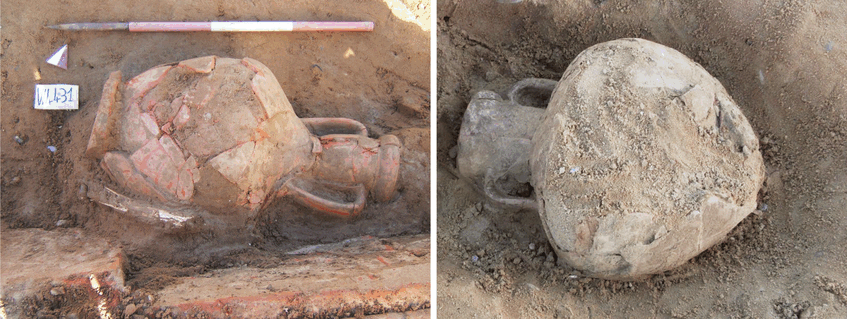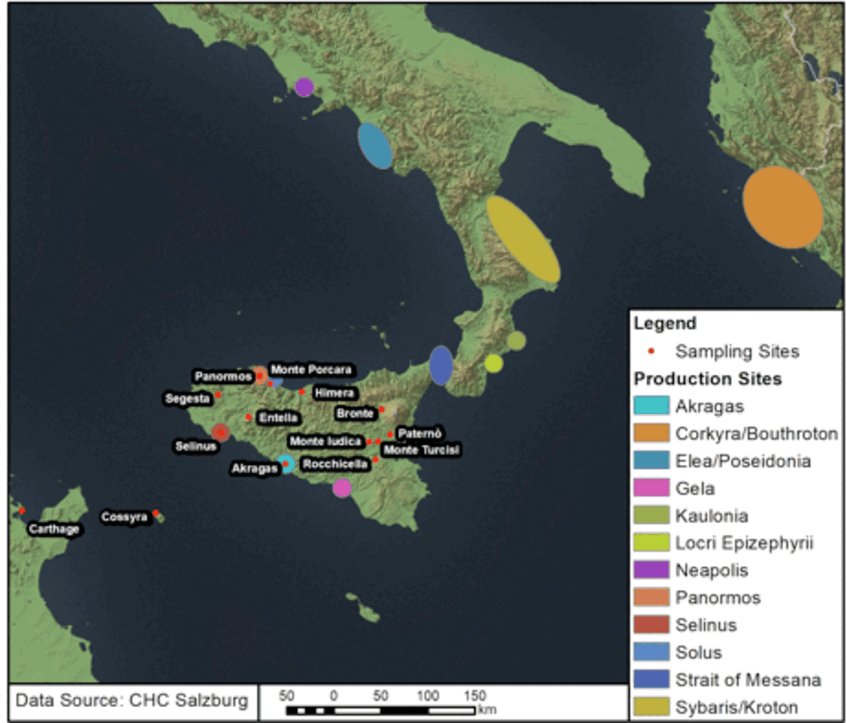Trade of western Greek amphorae (6th-5th century BC) from the perspective of Himera (western Sicily): a contribution to the identification of production centres, typological repertoires and distribution patterns
Project affiliation:
- Institut für Klassische Archäologie, Universität Wien.
Project leader:
- Babette Bechtold (Institut für Klassische Archäologie, Universität Wien).
Co-authors:
- Stefano Vassallo (Soprintendenza BBCCAA di Palermo)
- Giuseppe Montana, Luciana Randazzo (Dipartimento di Scienze della Terra e del Mare, Università degli Studi di Palermo).
Cooperation partners:
- C. Marconi (New York University, IFA / Università Statale di Milano): excavations at temples B and R, Selinunte
- M. de Cesare, C. Portale, A. Amico (Università degli Studi di Palermo): excavations in the area at South of the temple of Zeus, Agrigento
- V. Baldoni, M. Scalici (Università di Bologna) and M.C. Parello (Parco Archeologico della Valle dei Templi di Agrigento): excavations of the kiln site outside ‘Porta V’, Agrigento
- L. Caliò, M. Gerogiannis (Università di Catania) and M.C. Parello (Parco Archeologico della Valle dei Templi di Agrigento): excavations at the ‘Tempio Romano’, Agrigento.
- M. de Cesare, P. Cipolla (Università degli Studi di Palermo), M. Quartararo (Pisa): study of the archaeological materials of the Grotta Vanella dump and the Mango sanctuary, Segesta.
- A. Corretti, C. Michelini (Scuola Normale Superiore di Pisa): excavations and survey at Entella.
- L. Maniscalco, M. Turco (Soprintendenza di Catania): sampling of smaller selections of ceramic materials from Bronte, Paternò, Monte Iudica and Rocchicella.
- M. Jonasch (Deutsches Archäologisches Institut Berlin): excavations at Monte Turcisi.
- R. Docter (Department of Archaeology, Ghent University), excavations at Bir Messaouda, Carthage.
- T. Schäfer (Institut für Klassische Archäologie, Universität Tübingen): acropolis excavations, Pantelleria.
Staff at the ceramic lab of the University of Vienna:
- Flavio Ferlito
- Raphael Lampl
Graphic documentation of the amphorae from Himera:
- Giancarlo Guadagnino
Financial support:
- FWF Austrian Sciences Fund, P 30030-G25
Duration:
- Decembre 2017 – Novembre 2021
Western Greek amphorae, namely transport vessels produced by southern Italian and Sicilian colonies during the 6th-5th centuries BC, represent one of the most common ceramic classes found in Central Mediterranean archaeological contexts. The aforementioned provide fundamental information regarding economic interaction in the whole region. However, the production sites identification and repertoires are far from completion. Important morphological differences between the series produced by Greek towns located in the Tyrrhenian, Calabrian and Ionian-Adriatic area have already been ascertained, whereas typological information regarding the chronological development of the Sicilian products appears to be still very scare.
The present project focuses on the largest ensemble of western Greek amphorae ever excavated in the Mediterranean and unearthed in enchytrismoi found in the necropolis of Himera (fig. 1-2).

Fig. 1. Aerial view of the site of Himera with location of the western and eastern necropolis (archivio Soprintendenza BBCCAA di Palermo).

Fig. 2. Examples of western Greek amphorae reused in enchytrismoi excavated in the western necropolis (W4431 to the left, W4450 to the right, archivio Soprintendenza BBCCAA di Palermo).
Determining both (fig. 3) fabric (according to the methods of FACEM, see www.facem.at) and type of about 560 well preserved vessels aims to work on a diachronic serialisation of fabric groups attributed to production sites/regions. Archaeometric analysis and comparison with edited geochemical data by G. Montana and L. Randazzo will play a crucial role in view of the geographic attribution of these groups. A particular emphasis will be placed on the identification of the almost unknown series of some Sicilian Colonies, for instance, the Greek foundations of Selinus and Akragas on the southern coast, as well as the Punic towns of Solus and Panormos in the North-West region. Correctly dating the vessels will depend on morphological comparisons and the chronology referred to the associated grave inventories and other archaeological data studied by the excavator, S. Vassallo.

Fig. 3. Amphora W1751 of Sourisseau's form 2 from the western necropolis of Himera. To the left microphoto x8, to the right profile drawing (from: B. Bechtold, S. Vassallo, Le anfore puniche dalle necropoli di Himera (seconda metà del VII – fine del V sec. a.C., BABesch Supplemento 34, 2018, 154, fig. 58).
Further information will be provided by the analysis of approximately 250 fragments of western Greek amphorae from other Sicilian sampling sites (fig. 4). This procedure will allow both to outline regional distribution patterns of the main identified productions and strengthen evidence for local production at Selinus and Akragas.
Given Himera's function as a distribution centre not only for the indigenous and Elymian sites of its hinterland, but also for the Sicilian-Punic colonies and Carthage itself, the present research will constitute a mile stone for the study of economic interaction, during the 6th-5th centuries BC in north-western Sicily. Furthermore, particularly relevant to the characterisation of the later 5th-century BC series is Himera’s destruction date of 409 BC. Finally, special emphasis will be placed on the assessment of the quantitative proportions of regionally produced vessels versus commodities imported from supra-regional areas. Concerning the latter ones, we have to verify if Himera’s international commercial relations predominately linked to the Tyrrhenian route. Other conceivable provenance areas of important quantities of amphorae are represented by the Ionian-Adriatic region, the Straits of Messina area, Ionian Calabria and south-eastern Sicily.

Fig. 4. Already identified production areas/sites of western Greek amphorae and sampling sites to be included in the present project.
Essential references
- Azzaro E., Barone G., Belfiore C., Mazzoleni P., Montana G., Pezzino A., Spagnolo G., Toti M.P., 2006 , Indagini minero-petrografiche e geochimiche su anfore del V e IV sec. a.C. provenienti da Selinunte, in: C. D'Amico (ed.), Atti del convegno di Caserta dell'Associazione Nazionale di Archeometria, Bologna, 219-228.
- Barone G., Crupi V., Galli S., Majolino D., Migliardo P., Spagnolo G., 2004, Mineralogical-Petropraphic and Spectroscopic Investigations on Coarse Pottery and Transport Amphorae from Agrigento, Mediterranean Archaeology and Archaeometry 4.1, 47-59.
- Barone G., Crupi V., Galli S., Longo F., Majolino D., Mazzoleni P., Spagnolo G., 2004, Archaeometric analyses on 'Corinthian B' transport amphorae found at Gela (Sicily, Italy), Archaeometry 46.4, 553-568.
- Barone G., Ioppolo S., Majolino D., Branca C., Sannino L., Spagnolo G., Tigano G., 2005, Archaeometric analyses on pottery from archaeological excavations in Messina (Sicily, Italy) from the Greek archaic to the Medieval age, Periodico di Mineralogia, 74.1, 11-41.
- Barone G., Belfiore C.M., Mazzoleni P., Spagnolo G., Tigano G., Triscari M., 2011, Le anfore commerciali dell'Occidente greco in età arcaica e classica: problemi di localizzazione delle fabbriche, in: S. Gualtieri et al. (eds.), La ceramica e il mare. Il contributo dell'archeometria allo studio della circolazione dei prodotti nel Mediterraneo (Genova 2008), Roma, 87-102.
- Barone G., Mazzoleni P., Spagnolo G., Acquilia E., 2012, The transport amphorae of Gela: a multidisciplinary study on provenance and technological aspects, Journal of Archaeological Science, 39, 11-22.
- Barra Bagnasco M., Casoli A., Chiari G., Compagnoni R., Davit P., Mirti P., 2001, Mineralogical and chemical composition of transport amphorae excavated at Locri Epizephiri (southern Italy), Journal of Cultural Heritage 2.3, 229-239.
- Bechtold B., 2013, Distribution Patterns of Western Greek and Punic Sardinian Amphorae in the Carthaginian Sphere of Influence (6th-3rd century BCE), Carthage Studies 7, 43-119.
- FACEM: Gassner V., Trapichler M., Bechtold B. (eds.), Provenance Studies on Pottery in the Southern Central Mediterranean from the 6th to the 2nd c. B.C., version 5 of 6.12.2015, http://www.facem.at/.
- Gassner V., 2003, Materielle Kultur und kulturelle Identität in Elea in spätarchaisch-frühklassischer Zeit. Untersuchungen zur Gefäß- und Baukeramik aus der Unterstadt (Grabungen 1987-1994) (Archäologische Forschungen 8. Velia-Studien 2), Wien.
- Gassner V., Sauer R., 2008, Thin section and heavy mineral analyses of western Greek amphorae samples, in: Nieto X., Santos M. (eds.), El vaixell grec arcaic de Cala Sant Vicenç, Gerona, 355-371.
- Montana G., 2011, Le "argille ceramiche" della Sicilia occidentale e centrale (Terra e ambiente 2), Enna.
- Montana G., Bechtold B., Polito A.M., Randazzo L., 2018, Selinunte (Sicily) and its productive context: the clayey materials applied in a long-living ceramic production (7th-3rd century BCE), Archaeological and Anthropological Sciences 10, 657-673.
- Savelli S., 2006, Le anfore da trasporto, in: M. Cuozzo, B. d'Agostino, L. Del Verme (eds.), Cuma. Le fortificazioni 2. I materiali dai terrapieni arcaici, Napoli, 103-257.
- Savelli S., 2009, Anfore greco-occidentali in Magna-Grecia: un aggiornamento sul tipo 'corinzio B arcaico' e 'ionico-massaliota', in: F. Camia, S. Privitera (eds.), Obeloi. Contatti, scambi e valori nel Mediterraneo antico. Studi offerti a Nicola Parise (Fondazione Paestum. Tekmeria 11), Paestum-Atene, 105-129.
- Sourisseau J.-Chr., 2011, La diffusion des vins grecs d’Occident du VIIIe au IVe s. av. J.-C., sources écrites et documents archéologiques, in: La vigna di Dioniso : vite, vino e culti in Magna Grecia, Atti del quarantanovesimo Convegno di Studi sulla Magna Grecia (Taranto 2009), Vol. 49, 145-252.
- Sourisseau J.-Chr., 2012, Documents archéologiques et réseaux d'échanges en Méditerranée centrale (VIIIe-VIIe s. a.C.), in: L. Capdetrey, J. Zurbach (eds.), Mobilités grecques. Mouvement, réseaux, contacts en Méditerranée de l'époque archaïque à l'èpoque hellénistique (Scripta Antiqua 46), Bordeaux, 179-197.
- Vassallo S., 2009, La colonia di Himera lungo le rotte dei commerci mediterranei. Il contributo delle anfore da trasporto, in: R. Panvini, C. Guzzone, L. Sole (eds.), Traffici, commerci e vie di distribuzione nel Mediterraneo tra Protostoria e V secolo a.C. Atti del Convegno Internazionale (Gela 2009), Caltanissetta, 149-157.
